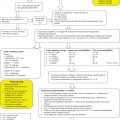Chapter 2
Provision of Nutrition in a Hospital Setting
Ruth Watling
Introduction
The provision of adequate and appropriate nutrition for infants, children and young people in hospital presents a significant challenge. It must take into account the diverse needs of the paediatric inpatient population in terms of age, development stage, ethnicity and religious beliefs. Furthermore provision of nutrition encompasses the requirements of the nutritionally well, the nutritionally vulnerable and those requiring therapeutic diets. Dietitians will be involved predominantly with the latter two groups but must also act in an expert advisory capacity to those involved with the provision of food to the nutritionally well.
Nutrition care planning
Data on prevalence of undernutrition amongst paediatric inpatients indicate an incidence between 6% and 14% [1]. A child’s nutritional status can deteriorate over the course of a hospital admission [2]. In chronic childhood diseases the contribution of frequent and extended admissions combined with the impact of treatment may have a negative effect on nutritional intake and consequently on nutritional status.
The use of a nutrition screening tool should, in theory, provide a simple and rapid means of determining those at risk and those who have specific dietary requirements. From this information a nutritional care pathway for each individual patient can be determined, implemented and monitored. There are a number of paediatric nutrition screening tools available and in a variety of stages of validation [3–5]. There is as yet no universally accepted paediatric nutrition screening tool for the assessment of paediatric inpatients and recent work indicates variable correlation with anthropometric assessment when comparing two of the tools and a need for further validation [6].
Additionally when considering the possible use of a nutrition screening tool for hospital inpatients the enormity of the task should not be underestimated. Between 760 000 and 1.15 million children are admitted annually to UK hospitals with an average length of stay of 2.1 days [7].
In summary, individual nutrition care planning is a prerequisite to optimum nutritional provision but needs to be undertaken in such a way that there is confidence that it can identify the significant numbers who are already malnourished, those who are at risk of becoming so and those with specific requirements, whilst avoiding unnecessary screening of those who are nutritionally well and undergoing a relatively short length of hospital stay.
Condition specific tools, such as the one recently developed for children and young people with cancer (p. 661), may be a more appropriate future strategy to identify nutritional risk amongst paediatric inpatients [8]. Further information about nutrition screening tools may be found in Chapter 1, p. 3.
Nutritionally well inpatients
Provision of nutrition to nutritionally well inpatients should take into account:
- age and developmental stage of the patient
- religious and cultural beliefs
- the need to provide adequate food and fluid to meet normal nutritional requirements within a healthy balanced diet
- food provided should be familiar, tasty and available at the right time for the child; a hospital admission may provide the opportunity to promote aspects of healthier eating to families
Nutritionally well infants
Paediatric inpatient facilities should make every effort to enable mothers to breast feed their infants except for the rare event of a clinical reason to stop breast feeding. Support should include facilities for mothers to feed in comfort, respecting their privacy and dignity; support, facilities and equipment for mothers to express breast milk; safe and hygienic storage of expressed breast milk. Evidence is emerging that breast feeding can be sustained even in infants requiring significant surgical intervention [9].
For infants who are not breast fed and who do not require a specialised infant formula, there should be provision of ready-to-feed (RTF) infant milks. This will minimise the potential infection risks which could result from reconstituting powdered infant milks at ward level and ensure uniform composition. Ideally a selection of both whey and casein dominant milks should be available to meet the personal preference of the family. However, casein dominant RTF formulas are less easily available in UK hospitals and parents can be reassured that their infants’ nutritional needs will be adequately met providing the correct volume of any approved infant milk is provided.
For infants from 6 months of age and older appropriate weaning foods should form part of the catering provision.
Nutritionally well children and young people
The food and drinks on offer for nutritionally well children and young people should be designed to meet normal nutritional requirements and promote a healthy balanced diet of familiar foods. Despite a number of initiatives there are no mandatory standards for hospitals in England or Northern Ireland. In Scotland and Wales there are standards in place for caterers to follow which can act as a guide for dietitians to assess the nutritional adequacy of the hospital menu [10, 11]. In the absence of mandatory standards there are good practice guidelines for the hospital menu [12] which include:
- meeting the estimated average requirement (EAR) for energy [13] daily; this can be achieved by provision of energy dense items, by increasing frequency of meals and by providing favourite foods at flexible times throughout the day
- meeting the reference nutrient intake (RNI) for protein [13] daily; this is almost always achieved if the EAR for energy is met
- meeting the RNI for vitamins and minerals over the course of a week
- encouraging a good fluid intake with six to eight drinks daily
- specific nutrients worthy of individual note
- Calcium: 350−500 mL milk should be available to all patients; full fat for under 2 years and semi-skimmed for others
- Vitamin C: 200 mL fruit juice for all and provision of fresh fruit and vegetables
- Iron: inclusion of red meat dishes, iron fortified breakfast cereals, green leafy vegetables and pulses
- Vitamin D: provision of adequate vitamin D in the diet is a challenge; supplementation may be required in long stay patients or those at specific risk of deficiency
- Calcium: 350−500 mL milk should be available to all patients; full fat for under 2 years and semi-skimmed for others
The high sodium content of hospital meals has been noted and caterers should be advised to adhere to age specific recommendations [14].
Children in hospital should be provided with breakfast, two main meals and two to three snacks daily. A wide variety of portion sizes will be necessary to ensure that protein and energy requirements are met across the age ranges (Table 2.1). Food should be served in a manner and in an environment that encourages eating. Crockery and cutlery appropriate to the age ranges are required. Menu choices should meet the needs of vegetarians and those with specific cultural or religious beliefs (Chapter 27).
Table 2.1 Food portion sizes for age
| 1−2 years | 3−5 years | 10+ years | 12+ years | |
| Meal pattern | 3 small meals and 3 snacks plus milk | 3 meals, 2−3 snacks or milk drinks | 3 meals, 1−2 snacks or milk drinks | 3 meals and 2−3 snacks |
| Protein sources, e.g. meat, fish, eggs, pulses | 20−40 g or 2−4 tablespoons or 1 small item, e.g. fish or chicken goujon, egg | 50−80 g or 4−8 tablespoons or 1−3 items depending on size, e.g. 2 fish fingers, 1 egg | 90−120 g or 9−10 tablespoons or 1−3 items depending on size | 120 g or 10 tablespoons or 2−3 items |
| Dairy | 20 g cheese, 1 small pot yoghurt, 1 cup milk, 5−8 tablespoons custard | 20−30 g cheese, 2 small or 1 standard pot yoghurt, 1 glass milk, 8−10 tablespoons custard | 30−40 g cheese, 1 standard pot yoghurt, 1 glass milk, bowl of custard | 50−60 g cheese, 1−2 standard pots yoghurt, 1 large glass milk, bowl of custard |
| Bread and other carbohydrates | ½−1 slice or ½−1 item, e.g. crumpet, bagel, 3−5 tablespoons pasta or rice, 1−2 tablespoons potato, 3−5 tablespoons breakfast cereal | 1 slice or 1 item, 6−8 tablespoons pasta or rice, 2−3 tablespoons potato, 6−8 tablespoons breakfast cereal or 1−2 Weetabix | 2 slices or 2 items, 10−15 tablespoons pasta or rice, 3−4 tablespoons potato, bowl of breakfast cereal or 2 Weetabix | 2−3 slices or items, 10−20 tablespoons pasta or rice or 4−6 tablespoons potato, bowl of breakfast cereal or 2−3 Weetabix |
| Fruit and vegetables Portion sizes to increase with age | 5 a day | 5 a day | 5 a day | 5 a day |
1 tablespoon = 15 g.
The nutritionally vulnerable and those requiring therapeutic diets
Patients in this group will require some or all of the following during the course of a hospital admission:
- adapted infant milks and specialised formulas
- enteral feeds
- parenteral nutrition (Chapter 4)
- nutrient dense meals
- therapeutic diets
Adapted infant milks and specialised formulas
A designated feed preparation area is required to prepare adapted infant milks, e.g. by thickening or by the addition of nutrients, or to prepare specialised formulas. Patients requiring such feeds are likely to be those at greatest nutritional risk; therefore the highest standards of accuracy are required to ensure the prescribed nutritional content is achieved.
Powdered formulas are a potential medium for bacterial and microbial growth. They are not sterile and have the potential to present an infection risk of Cronobacter sakazakii (formerly Enterobacter sakazakii) or salmonella species. Therefore hygiene standards in designated feed preparation areas are of paramount importance. The World Health Organization (WHO) has issued advice for the preparation of powdered formulas for individual infants at home; they are best prepared freshly for each feed [15]. This is not practical for hospitals making large volumes of powdered infant feeds and specialised formulas.
Guidelines for the preparation of adapted infant milks and specialised formulas
In the UK there are no mandatory standards for feed preparation areas in hospital settings. A designated feed making unit is necessary in large hospitals preparing in excess of 15−20 feeds daily, with separate areas for storage, preparation and cleaning. For hospitals and paediatric units preparing less than 15 feeds daily a designated feed preparation room should be sufficient.
Feed preparation must comply with the requirements of the Food Safety Act 1990 [16]. The Paediatric Group of the British Dietetic Association has produced best practice guidelines and, in conjunction with the comprehensive guidelines from the American Dietetic Association, these documents provide essential reference standards for safe, effective and efficient feed making units [17, 18] which are summarised below.
Structural design of feed making areas
Stay updated, free articles. Join our Telegram channel

Full access? Get Clinical Tree





